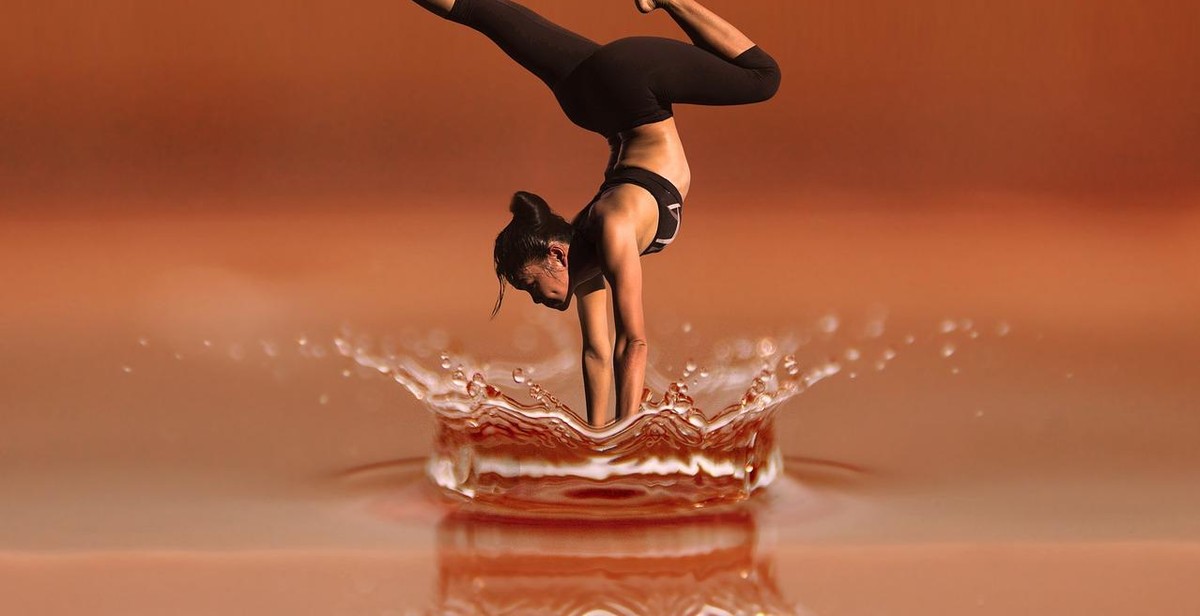How to Incorporate Yoga into Your Fitness Routine: Benefits and Beginner Poses
Yoga is a form of exercise that has been around for centuries. It is a practice that combines physical postures, breathing techniques, and meditation to improve overall health and well-being. Incorporating yoga into your fitness routine can have numerous benefits, including increased flexibility, strength, and balance.
The Benefits of Yoga
Yoga has been shown to have a positive impact on both physical and mental health. Some of the benefits of practicing yoga regularly include:
- Improved flexibility and range of motion
- Increased muscle strength and tone
- Better balance and posture
- Reduced stress and anxiety
- Improved sleep quality
- Enhanced mental focus and concentration
Beginner Yoga Poses
If you’re new to yoga, it can be overwhelming to know where to start. Here are some beginner-friendly yoga poses to get you started:
- Mountain Pose (Tadasana)
- Downward-Facing Dog (Adho Mukha Svanasana)
- Warrior II (Virabhadrasana II)
- Tree Pose (Vrksasana)
- Child’s Pose (Balasana)
These poses are easy to learn and can be done in the comfort of your own home. As you progress, you can add more challenging poses to your routine.
The Benefits of Yoga in Your Fitness Routine
Yoga is a physical, mental, and spiritual practice that originated in ancient India. It has gained popularity worldwide due to its numerous benefits for the mind and body. Incorporating yoga into your fitness routine can have a significant positive impact on your overall health and well-being.
Increased Flexibility and Range of Motion
Yoga involves a variety of stretching exercises that can help increase your flexibility and range of motion. The postures, also known as asanas, help stretch and lengthen your muscles, improving your overall flexibility. Improved flexibility can help prevent injuries, reduce muscle soreness, and improve your posture.
Improved Strength and Endurance
Yoga requires holding certain postures for an extended period, which can help build strength and endurance. The practice of yoga can also help tone your muscles and improve your overall physical fitness. Additionally, many yoga poses require you to support your body weight, which can help build upper body strength.
Reduced Stress and Anxiety
Yoga is known for its calming effect on the mind and body. The practice of yoga involves deep breathing exercises, which can help reduce stress and anxiety. Yoga also helps lower cortisol levels, the stress hormone, in the body, helping to reduce stress and anxiety levels.
Enhanced Mind-Body Connection
Yoga involves a focus on breathing, meditation, and mindfulness, which can help improve your mind-body connection. Regular practice of yoga can help you become more aware of your body, thoughts, and emotions, helping you to better manage stress and improve your overall well-being.
| Benefits of Yoga in Your Fitness Routine | |
|---|---|
| Increased Flexibility and Range of Motion | Prevents injuries, reduces muscle soreness, improves posture |
| Improved Strength and Endurance | Builds strength and endurance, tones muscles, builds upper body strength |
| Reduced Stress and Anxiety | Calming effect on mind and body, reduces cortisol levels, reduces stress and anxiety levels |
| Enhanced Mind-Body Connection | Improves mind-body connection, helps manage stress, improves overall well-being |
Overall, incorporating yoga into your fitness routine can have numerous benefits for your mind and body. Whether you are a beginner or an experienced yogi, there are many poses and styles of yoga to choose from that can help you achieve your fitness goals.

How to Incorporate Yoga into Your Fitness Routine: Benefits and Beginner Poses
If you’re looking to improve your overall fitness and flexibility, incorporating yoga into your exercise routine can be a great option. Yoga offers a range of physical and mental benefits, including improved strength, balance, and stress relief. Here are some tips to help you get started:
Start with a Beginner Class
Even if you’re an experienced fitness enthusiast, it’s important to start with a beginner yoga class. This will allow you to learn the basics of yoga, including proper alignment and breathing techniques. It can also help you avoid injury and frustration as you begin to explore the practice.
Choose a Style that Complements Your Fitness Goals
There are many different styles of yoga to choose from, each with its own unique benefits. Some styles, like Vinyasa or Power Yoga, are more physically demanding and can help you build strength and endurance. Other styles, like Restorative or Yin Yoga, are more focused on relaxation and stress relief. Consider your fitness goals and choose a style that complements them.
Practice Consistently
Like any form of exercise, consistency is key when it comes to seeing results from yoga. Aim to practice at least once or twice a week to start, and gradually increase your frequency as you become more comfortable with the practice. Consistent practice can help you improve your strength, flexibility, and overall fitness level.
Combine Yoga with Other Forms of Exercise
While yoga can be a great standalone exercise, it can also be an effective complement to other forms of exercise. For example, practicing yoga can help improve your balance and flexibility, which can in turn improve your performance in activities like running or weightlifting. Consider incorporating yoga into your existing fitness routine for maximum benefits.
- Start with a beginner class to learn the basics of yoga
- Choose a style that complements your fitness goals
- Practice consistently to see results
- Combine yoga with other forms of exercise for maximum benefits
By following these tips, you can begin to incorporate yoga into your fitness routine and start reaping the many physical and mental benefits of this ancient practice.

Beginner Yoga Poses to Incorporate into Your Fitness Routine
Mountain Pose (Tadasana)
Mountain pose is a great pose for beginners as it helps in stretching your entire body and improves your posture. To perform this pose:
- Stand straight with your feet hip-width apart.
- Place your hands by your side and relax your shoulders.
- Breathe in and lift your toes off the ground, balancing on your heels. Hold for a few seconds.
- Breathe out and lower your toes back to the ground.
- Repeat this pose for 3-4 times.
Downward-Facing Dog (Adho Mukha Svanasana)
Downward-facing dog pose is a great pose to stretch your hamstrings and calves. To perform this pose:
- Start on your hands and knees with your wrists under your shoulders and your knees under your hips.
- Exhale and lift your knees away from the floor.
- Keep your knees slightly bent and your heels lifted away from the floor.
- Lengthen your tailbone away from the back of your pelvis and press it lightly toward the pubis.
- Hold this pose for a few breaths and then release.
Warrior I (Virabhadrasana I)
Warrior I pose is a great pose for strengthening your legs, arms, and back muscles. To perform this pose:
- Stand straight with your feet hip-width apart.
- Step your left foot back and turn it out at a 45-degree angle.
- Bend your right knee and keep it directly over your ankle.
- Extend your arms overhead and gaze up at your hands.
- Hold this pose for a few breaths and then release.
Tree Pose (Vrksasana)
Tree pose is a great pose for improving your balance and strengthening your legs. To perform this pose:
- Stand straight with your feet hip-width apart.
- Shift your weight onto your left foot and lift your right foot off the ground.
- Place the sole of your right foot on your left thigh, with your toes pointing down.
- Bring your hands together in front of your heart.
- Hold this pose for a few breaths and then release.
Bridge Pose (Setu Bandha Sarvangasana)
Bridge pose is a great pose for strengthening your back muscles and improving your posture. To perform this pose:
- Lie on your back with your knees bent and your feet flat on the ground.
- Place your arms by your side with your palms facing down.
- Press your feet into the ground and lift your hips up toward the ceiling.
- Hold this pose for a few breaths and then release.
| Mountain Pose (Tadasana) | Downward-Facing Dog (Adho Mukha Svanasana) | Warrior I (Virabhadrasana I) | Tree Pose (Vrksasana) | Bridge Pose (Setu Bandha Sarvangasana) |
These beginner yoga poses are a great way to incorporate yoga into your fitness routine. Remember to listen to your body and take it slow. With regular practice, you will soon notice the benefits of yoga on your mind and body.

Conclusion
Adding yoga to your fitness routine can be one of the best decisions you make for your physical and mental health. The benefits of yoga are numerous, including improved flexibility, balance, strength, and stress reduction.
As a beginner, it can be overwhelming to start a yoga practice, but there are many beginner-friendly poses you can try. Start with simple poses like downward-facing dog, child’s pose, and warrior II, and gradually work your way up to more advanced poses.
Remember, yoga is not a competition, and it’s important to listen to your body and go at your own pace. Don’t be discouraged if you can’t do a certain pose right away. With practice and patience, you will see progress.
Tips for Incorporating Yoga into Your Fitness Routine
- Schedule a specific time for your yoga practice to make it a habit.
- Find a class or instructor that resonates with you.
- Invest in a good quality yoga mat.
- Don’t skip the warm-up and cool-down stretches.
- Experiment with different types of yoga to find what works best for you.
Overall, incorporating yoga into your fitness routine can have a positive impact on your physical and mental well-being. Whether you’re a seasoned athlete or a beginner, there’s a yoga practice for everyone. So, roll out your mat and give it a try!
